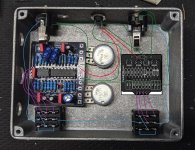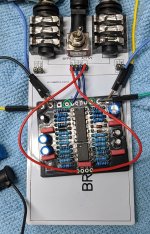I'm thinking through the layout and wiring strategy for a 2 effect combo pedal that I'm experimenting with. I've just roughed everything into a spare enclosure w/ a bunch of nonsense holes. Still haven't assembled the Squidward board, but it's mocked in there according to scale.
These are the PCBs I want to include:
I'm concerned about noise mitigation because some of the wire runs are a lot longer than I usually do. Wondering if anyone has suggestions for routing the wires so the circuit is a quiet as possible. I would imagine some of these would be good to twist together, but I realize maybe that only works in amplifier circuits.
I'm also wondering if I'm in for a world of hurt putting the waddle box pub so close to the input. In the final enclosure, I'll move the input closer to the middle so it doesn't hit the red film box cap. But of course I have to tilt the electro caps downward to get everything to fit.
Thoughts? Suggestions? Prayers?
These are the PCBs I want to include:
- Waddle Box
- Squidward
I'm concerned about noise mitigation because some of the wire runs are a lot longer than I usually do. Wondering if anyone has suggestions for routing the wires so the circuit is a quiet as possible. I would imagine some of these would be good to twist together, but I realize maybe that only works in amplifier circuits.
I'm also wondering if I'm in for a world of hurt putting the waddle box pub so close to the input. In the final enclosure, I'll move the input closer to the middle so it doesn't hit the red film box cap. But of course I have to tilt the electro caps downward to get everything to fit.
Thoughts? Suggestions? Prayers?



